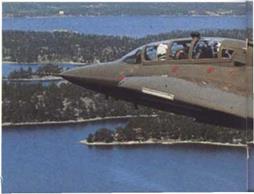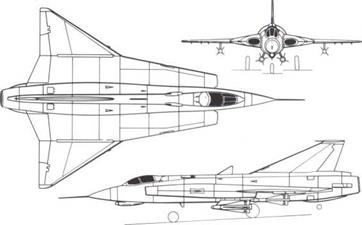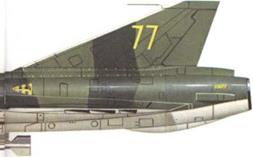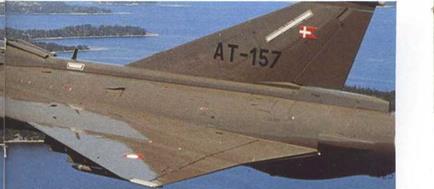Saab 35 Draken
J35A, В, D and F, Sk35C, S35E and export versions
Origin: Saab-Scania AB, Linkoping, Sweden.
Type: (J35) single-seat all-weather fighter-bomber: (Sk35) dual trainer; (S35) single-seat all-weather reconnaissance.
Engine: One Svenska Flygmotor RM6 (licence-built Rolls-Royce Avon with SFA afterburner): (А, В, C) 15.0001b (6804kg) RM6B; (D, E, F and export) 17,1101b (7761kg) RM6C.
Dimensions: Span 30ft 10in (9 4m); length 50ft 4in (15 4m) (S35E, 52ft); height 12ft 9in (39m).
Weights: Empty (D) 16,0171b; (F) 18,1801b (8250kg), maximum loaded (A) 18,2001b; (D) 22.6631b; (F) 27,0501b (12,270kg); (F-35) 35.275lb (16,000kg).
Performance: Maximum speed (D onwards, clean) 1,320mph (21 25km/h, Mach 2-0), (with two drop tanks and two 1,0001b bombs) 924mph (1487 km/h, Mach 1 -4); initial climb (D onwards, clean) 34.450ft (10,500m)/min; service ceiling (D onwards, clean) about 65,000ft (20,000m); range (internal fuel plus external weapons, typical) 800 miles (1300km), (maximum fuel) 2,020 miles (3250km).
Armament: (A) two 30mm Aden M/55 in wings, four Rb 324 (Sidewinder) missiles; (B) as A plus attack ordnance to maximum of 2,200lb (1000kg); (C) none; (D) as В; (E) usually none but provision as A; (F) one 30mm Aden plus two Rb27 Falcon (radar) and two Rb28 Falcon (infra-red) missiles, plus two or four Rb324; (F-35) two 30mm Aden plus nine stores pylons each rated at 1,0001b (454kg) all usable simultaneously, plus four Rb324.
History: First flight 25 October 1 955; (production J35A) 15 February 1958; final delivery (35XS) 1975, (Danish TF-35) 1976.
Users: Denmark, Finland, Sweden (RSAF).
Development: Again in advance of any other country in Western Europe, the Saab 35 was designed in 1949-51 as an all-weather supersonic fighter able to use small airfields. Erik Bratt and his team arrived at the unique "double delta" shape after studying different ways of packaging the fuel and equipment, the best arrangement being with items one behind the other
 |
 Right: One of the last of more than 600 Drakens was this TF – 35XD, one of six of this versatile two-seat dual-control version to be supplied to the Danish air force in 1968-73 along with 20 of the formidable 35XD single-seat version.
Right: One of the last of more than 600 Drakens was this TF – 35XD, one of six of this versatile two-seat dual-control version to be supplied to the Danish air force in 1968-73 along with 20 of the formidable 35XD single-seat version.

Above: Three-view of the Falcon-armed J35F ("Filip” to the Swedish Air Force).
giving a long aircraft of very small frontal area. In 1960 attack wing F13 found the A (Adam) simple to fly and maintain, sensitive in pitch and yet virtually unbreakable. В (Bertil) was more complex, with S7 collision-course fire control integrated with the Swedish Stril 60 air defence environment. Most Sk35C trainers were converted Adams. D (David) was first to reach Mach 2, despite continual increases in weight mainly due to fuel capacity raised from 493 to 680 gallons. E (Erik) carries French OMERA cameras and in 1973 was updated with external British Vinten night/low-level pods. F (Filip) is an automatic interceptor with Ericsson (Hughes basis) radar of pulse-doppler type. Production was closed at 606 with 40 multi-role F-35/RF-35/TF-35 aircraft for Denmark and 12 XS for Finland assembled by Valmet Oy.


Left: The first version to enter service was the J35A, popularly called ‘Adam’ in the Swedish air force. This example, one of the first to be delivered to F13 (the Bravalla Flygflottilj) at Norrkoping in March 1960, is seen with Rb 324 Sidewinders in place.










